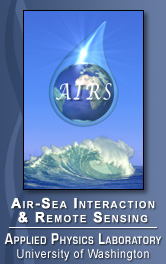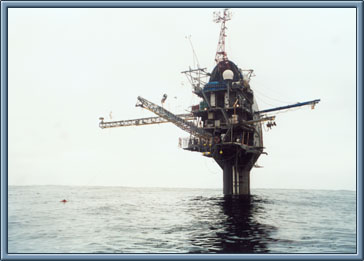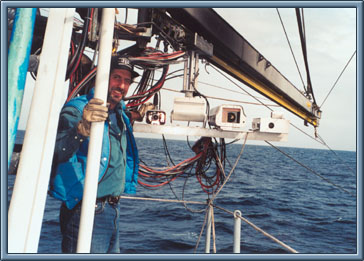
|
|

Andrew T. Jessup
Principal Oceanographer
AIRS Department
Applied Physics Laboratory
University of Washington
To the casual observer, the most obvious phenomena at the air-sea interface are ocean surface waves, especially large-scale breaking waves, or whitecaps. Less obvious is the phenomena of microscale wave breaking, or microbreaking, which occurs when small, wind-generated waves about 10 cm to 1 m long gently break. Because they do not generate visible bubbles when they break, microbreakers cannot be detected by the naked eye. However, remote sensing instruments using infrared and microwave technology can be used to detect and quantify the effect of these small but ubiquitous genera-tors of turbulent mixing and surface roughness. These short waves, driven by winds, increase to a height of a few centimeters until they become too steep to support themselves and consequently "break" in the sense that they overturn the water right at the surface. This process transfers momentum into the upper ocean as turbulence and mixing that enhances the transfer of heat and gas between the ocean and atmosphere. Recent work by members of the newly formed AIRS Department has revealed that microbreaking waves contribute significantly to air-sea fluxes. Can these fluxes-the transfer of momentum, heat, and gas across the air-sea boundary-be characterized and quantified by measuring their underlying physical mechanisms using remote sensing instruments? Principal Oceanographer Andy Jessup and Senior Oceanographer Bill Asher organized a recent field experiment to examine this and other current topics emphasizing the use of remote sensing to study air-sea interaction. The Fluxes, Air-sea Interaction, and Remote Sensing (FAIRS) experiment was a 32-day excursion aboard the research platform FLIP off the coast of Monterey, CA. FLIP is a unique 360-foot vessel that is towed to sea and is literally flipped up on end so that only the top 60 feet are above the water surface. The result is a stable platform for housing scientists and their instruments that is ideal for making remote sensing measurements at sea.
FAIRS was jointly funded by three ONR programs-Remote Sensing, Marine Meteorology, and Physical Oceanography. The exercise included the participation of scientists from the Institute of Ocean Sciences at Sydney, B.C., the Naval Research Laboratory, Washington, D.C., the University of Massachusetts, and Woods Hole Oceanographic Institution. |
The remote sensing instruments mounted on the decks and booms of FLIP included an infrared imager, microwave radiometers, microwave radars, and video cameras. Jessup and Asher used two infrared techniques to measure the turbulence generated by both whitecaps and microbreaking waves. A passive technique used the infrared imager to take a picture of the ocean's surface temperature, concentrating on the small but measurable temperature variations that occur when a breaking wave causes water from below to be mixed to the surface. An active technique used a CO2 laser to heat a patch of water. This heated patch was then monitored by the imager to time its decay. During rough seas when the surface was broken frequently and repeatedly by microbreaking, the heated patch cooled down in less that a second. During very calm conditions, the patch remained visible in the infrared image for several seconds. This length of time for the heated patch to revert to the surrounding surface temperature can be used to quantify the flux of heat at the surface as well as the amount of turbulent mixing.
One characteristic of a microbreaking wave is that small capillary waves of a few centimeters or less in length are generated on its forward face and travel along with the wave as it breaks. Principal Research Scientist Bill Plant is studying how these "parasitic" capillary waves on the leading edge of a microbreaker have an important effect on microwave radar measurements. These capillary waves ride along on the steep front face of microbreakers, thus they appear tilted with respect to the look angle of the radar. Because the amount of energy reflected back to the radar increases with the tilt of the surface, this tilting effect may explain why more reflected energy is observed than is predicted by current models. By combining infrared and microwave techniques, Plant and Jessup believe they can better answer questions about the role of microbreaking in surface fluxes and radar backscatter than if they applied their respective techniques alone. Microwave radiometers are currently used to measure wind speed from satellites by exploiting the dependence of ocean surface emissivity on surface roughness. Researchers are now working on a technique to extract wind direction using microwave radiometry. Because the wind direction signal is so small, the emissivity of foam generated by large-scale breaking waves becomes significant. While it has been known for some time that foam can affect microwave radiometer measurements, the emissivity of foam on the ocean surface has never been characterized in the open ocean. To characterize the effect of foam on radiometer measurements, a 3 x 7 meter raft made of gas permeable tubing was designed and deployed by Asher. The raft generated a uniform area of sea foam that filled the footprint of the microwave radiometer. This way, the researchers did not have to wait for the chance of a large breaking wave to pass and generate foam within the area of the radiometer's view. By measuring the microwave signal from the sea surface with and without foam, Asher and others can determine the foam's emissivity. The FAIRS experiment was the first time that this combination of infrared and microwave sensors has been deployed with an extensive suite of above- and below-surface measurements. The results demonstrate the value of comprehensive, multi-institutional collaborations in air-sea interaction and remote sensing. |


